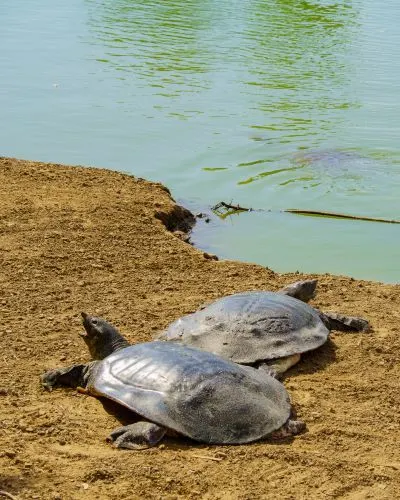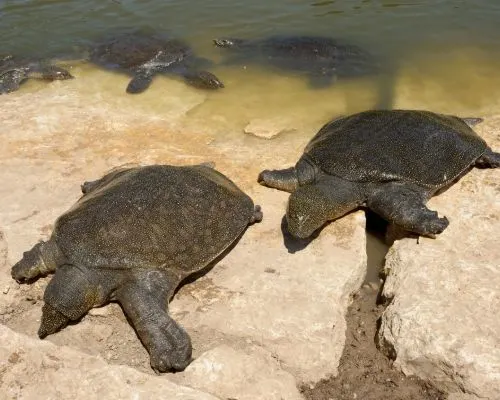The Trionyx triunguis is commonly known as the Nile softshell turtle or the African softshell turtle. As with all other softshell turtles, the Trionyx triunguis has a fleshy and leathery shell.
These species live in water predominantly. They are strong swimmers and can absorb oxygen from water. This means they rarely resurface to breathe. In addition, they are the only species of the genus Trionyx that isn’t extinct.
African Softshell Turtle Facts and Information
As suggested by their name, the Nile softshell turtle is endemic to the Nile, specifically the White and Blue Nile. They can also be found in the tributaries of the Sombreiro River in Nigeria and the Congo River. Unlike most turtles, the Nile softshell turtle can be found in freshwater bodies, brackish waters and even the sea.
These strong swimmers have no problem with the salinity of the water they live in. You can find them in the Atlantic sea off the West African shore and the Mediterranean Sea. However, they prefer lakes and rivers with muddy or sandy bottoms. They live in tropical regions with high temperatures.
The Trionyx triunguis is part of the family Trionychidae, which is comprised of softshell turtles. This species belong to the genus Trionyx of which they are the only extant species.
The Trionyx triunguis is also one of the largest softshells with a shell/carapace length of 37.5 inches or 95 cm. The carapace bones of the Trionyx triunguis is covered with a thick leathery skin. This is similar to other softshells like the black softshell turtle, and chinese softshell turtle.
The skin of this species is brownish olive in color and is covered in white spots, which sometimes have yellow rings around them. The plastron is white in color. The Trionyx triunguis has a snorkel-like nose and thick skin over the mouth.
In the wild, Trionyx triunguis has a lifespan of 24 to 45 years.
African Softshell Turtle Diet

The African softshells are mainly carnivorous creatures. The protein aspect of their diet consists mostly of aquatic insects, mollusks, worms, frogs, crustaceans, fish, small mammals, carrion and even other turtles.
The African softshells are excellent swimmers, which help them catch prey. They also hide in the muddy/sandy bottom of lakes and rivers and ambush prey using their long neck to quickly seize prey. In addition to this, they also eat seeds, nuts (such as dates and palm nuts) and fruits.
In zoos and captivity, this turtle will also eat liver and frog meat.
African Softshell Turtle Habitat

The African softshells prefer rivers and lakes with sandy or muddy substrates. They can live in freshwater bodies as well as brackish waters and the sea.
They prefer to spend most of their time in the water. They do leave the water to bask, and nest. In captivity, they require a pond and muddy or sandy substrates. In Turkey, they have been observed to bask between half a minute to 30 minutes. They are also known to bask in shallow water.
African Softshell Turtle Breeding

Little is known about the courtship and mating behavior of this species. However, nesting occurs from March to July. The exact months of nesting are dependent on the latitude. In the Mediterranean, these turtles lay their eggs on the earthen and sandbanks of islands.
In West Africa, they nest near the mouth of rivers. In Israel and Turkey, they nest upriver. One female usually lay 25 to over 100 eggs each nesting season. The incubation period of their eggs is 60 to 80 days. The hatchlings sex is determined genetically and not by temperature as with most turtles.
African Softshell Turtle Predators

The main adaptation of this turtle from predation is camouflage. When in water, their darkly colored shell and skin allows them to remain well hidden in dark water.
While their white underbelly (plastron) allows them to appear as clouds to predators underneath them. They are also strong and fast swimmers. They use their large claws and powerful jaws to defend themselves when attacked.
African Softshell Turtle Endangerment

According to the IUCN red list, the Trionyx triunguis is vulnerable to extinction. Although the species isn’t yet endangered, their population in the Mediterranean is under serious threat and is considered to be critically engendered.
While they are not directly hunted, African softshells with carapace lengths of 50 cm and over get caught by shrimp trawlers. Since this includes matured turtles of breeding age, it has a huge impact on their breeding. In addition, tourists are known to feed them.
This affects their ability to provide and hunt for themselves as they become reliant on people for nourishment.
In northeastern Africa, these turtles are hunted for food. Additionally, their carapaces (shells) are used to make guitars and shields.
Nile Softshell Turtle Swimming (Video)
Conclusion
The African softshell turtle is a difficult pet to and requires specific care. They can, however, be found in many zoos across the world such as the Toronto Zoo.
When properly cared for, these turtles have been known to live over 50 years. In fact, an African softshell turtle at the Smithsonian National Zoo in Washington, D.C. lived to be 53 years.
If you are looking for something else to do, why not check out all the other different types of turtles there are. Oh and let us know what you think in the comments below!
